Regardless if you run your own business or you are part of a team, you are going to encounter numerous problems. In these situations, a 5 whys methodology gives you some precious guidelines to find the solutions. In more detail, the 5 whys analysis means that you can ask questions to find the root cause of the issue. In this way, you can also find the right solution.
In this article, you are going to learn more about this root cause analysis technique and gain an invaluable problem-solving tool. Moreover, you will find several 5 whys example that fits your case to show you how to make the most out of this technique.

What Is the 5 Whys Technique
The 5 whys is a problem-solving method that uncovers the hidden root causes of any issue. Therefore, you must first clearly state the problem, and then repeatedly ask yourself “Why”. The deeper you go, the closer you will get to the actual root cause. Usually, answering 5 whys is enough to reach this point, that’s why it has become the standard for this technique.
Below, you will see some 5 whys analysis examples for several cases so that you can figure out how it works. Then, you can start creating this root cause analysis for the problems you encounter.
5 Whys Examples (5 Specific Whys and the Root Cause)
A 5 whys root cause analysis example shows you how to implement this technique in various situations. In this way, you can use the 5 whys example that is closer to your issue as a base to create a similar analysis for the problems you are dealing with. Let’s get started.
5 Whys Example – Taiichi Ohno
The first 5 whys analysis example is that of Taiichi Ohno, which was a former vice president of the Toyota Motor Corporation. In this 5 whys root cause analysis example, he tried to uncover the reason why the machines had stopped working. As you will see, the first why is very abstract and general. However, with each step, it starts to reveal the real causes behind the issue.
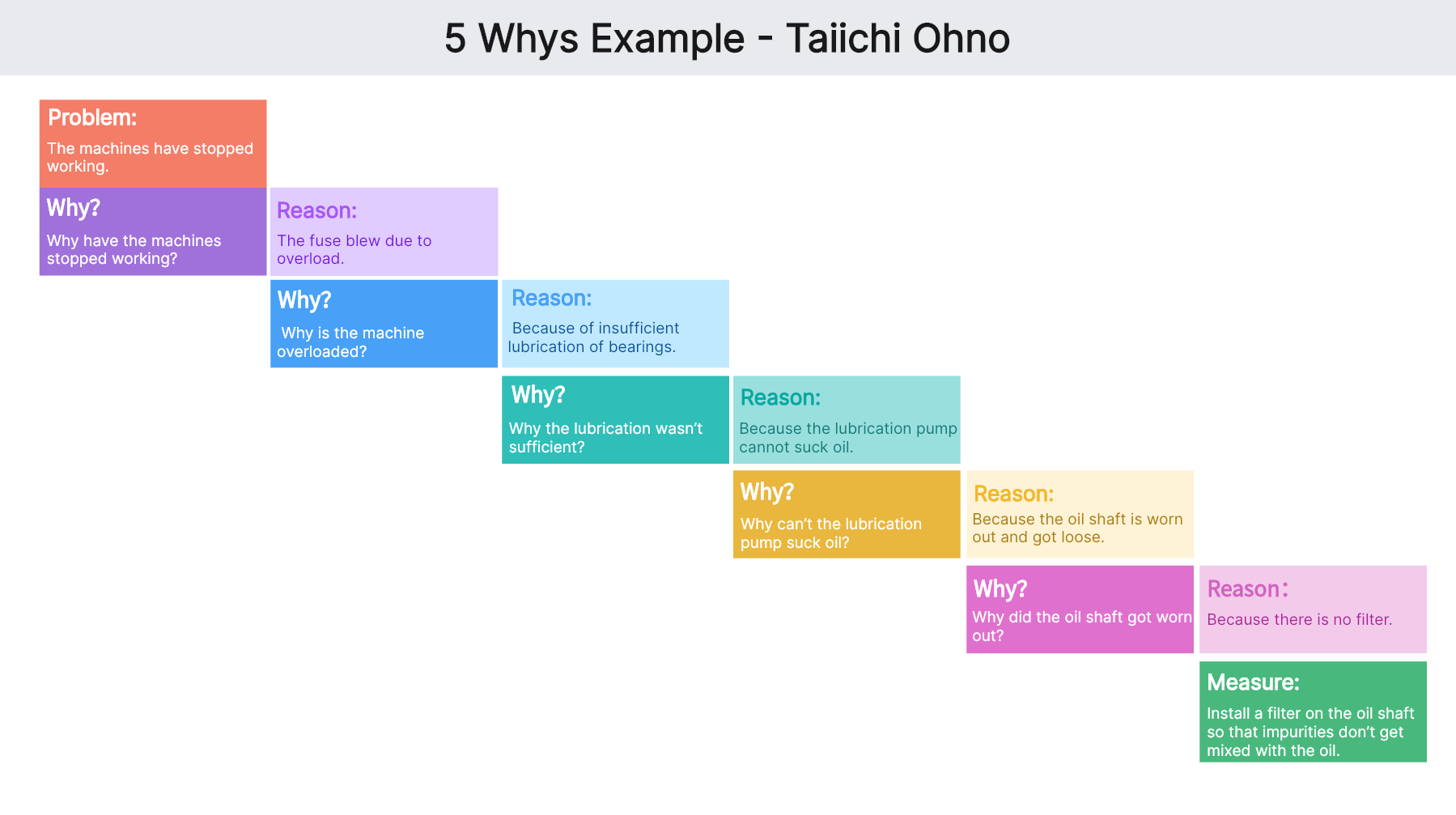
Problem – The machines have stopped working.
- Why 1 – Why have the machines stopped working?
- Reason – The fuse blew due to overload.
- Why 2– Why is the machine overloaded?
- Reason – Because of insufficient lubrication of bearings.
- Why 3– Why the lubrication wasn’t sufficient?
- Reason – Because the lubrication pump cannot suck oil.
- Why 4– Why can’t the lubrication pump suck oil?
- Reason – Because the oil shaft is worn out and got loose.
- Why 5– Why did the oil shaft got worn out?
- Reason – Because there is no filter.
Measure/Solution – Install a filter on the oil shaft so that impurities don’t get mixed with the oil.
5 Whys Example - Student
Actually, you can implement this technique on almost every problem you have in your life. For instance, you can use this root cause analysis method for your studies. In the following 5 whys root cause analysis example, we are going to examine how a student can use this technique to improve his grades and academic career.

Problem – I have failed my math exams.
- Why 1 – Why have I failed my math exams?
- Reason – Because I couldn’t answer correctly the geometry question.
- Why 2– Why didn’t I answer correctly the geometry question?
- Reason – Because I procrastinated and didn’t study enough.
- Why 3– Why did I procrastinate instead of studying?
- Reason – Because I couldn’t concentrate when I was trying to study.
- Why 4– Why couldn’t I concentrate while studying?
- Reason – Because I couldn’t understand how to solve the problems.
- Why 5– Why couldn’t I understand how to solve the geometry problems?
- Reason – Because I wasn’t paying attention in class.
Measure/Solution – Be more attentive in class and study more.
5 Whys Example - Customer Service
The following 5 whys root cause analysis example concerns a problem that has immerged in a retail store. You can use this technique to find out why your customer service is lacking and what you do to improve it. In this 5 whys analysis example, we will be dealing with a dissatisfied customer.
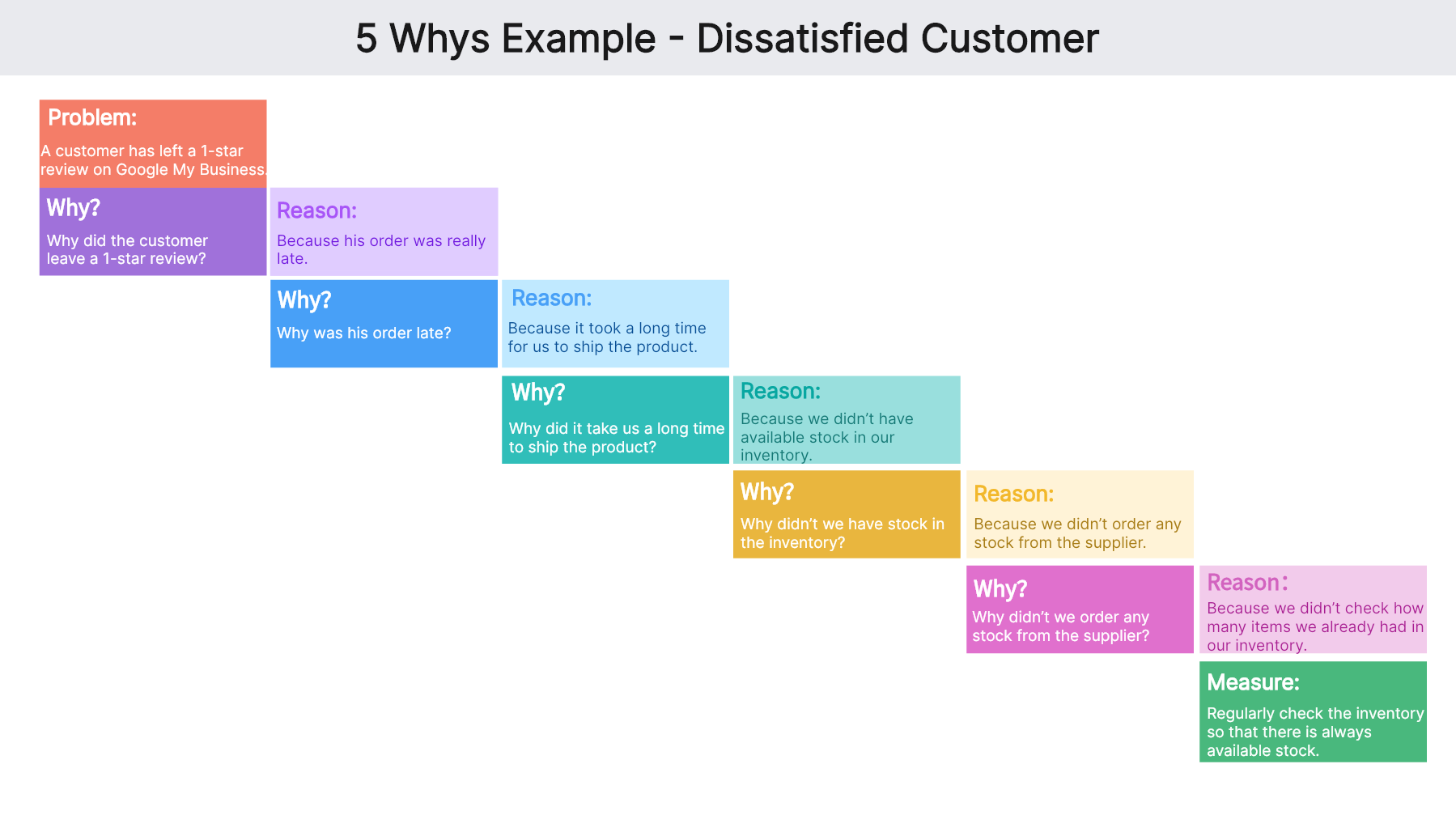
Problem – A customer has left a 1-star review on Google My Business.
- Why 1 – Why did the customer leave a 1-star review?
- Reason – Because his order was really late.
- Why 2– Why was his order late?
- Reason – Because it took a long time for us to ship the product.
- Why 3– Why did it take us a long time to ship the product?
- Reason – Because we didn’t have available stock in our inventory.
- Why 4– Why didn’t we have stock in the inventory?
- Reason – Because we didn’t order any stock from the supplier.
- Why 5– Why didn’t we order any stock from the supplier?
- Reason – Because we didn’t check how many items we already had in our inventory.
Measure/Solution – Regularly check the inventory so that there is always available stock.
5 Whys Example 4 - Project Issue
Another 5 whys root cause analysis example comes from an organization, where a project team seems to have an issue. With this technique, you can find out your team’s weaknesses that keep you from getting the best possible results.
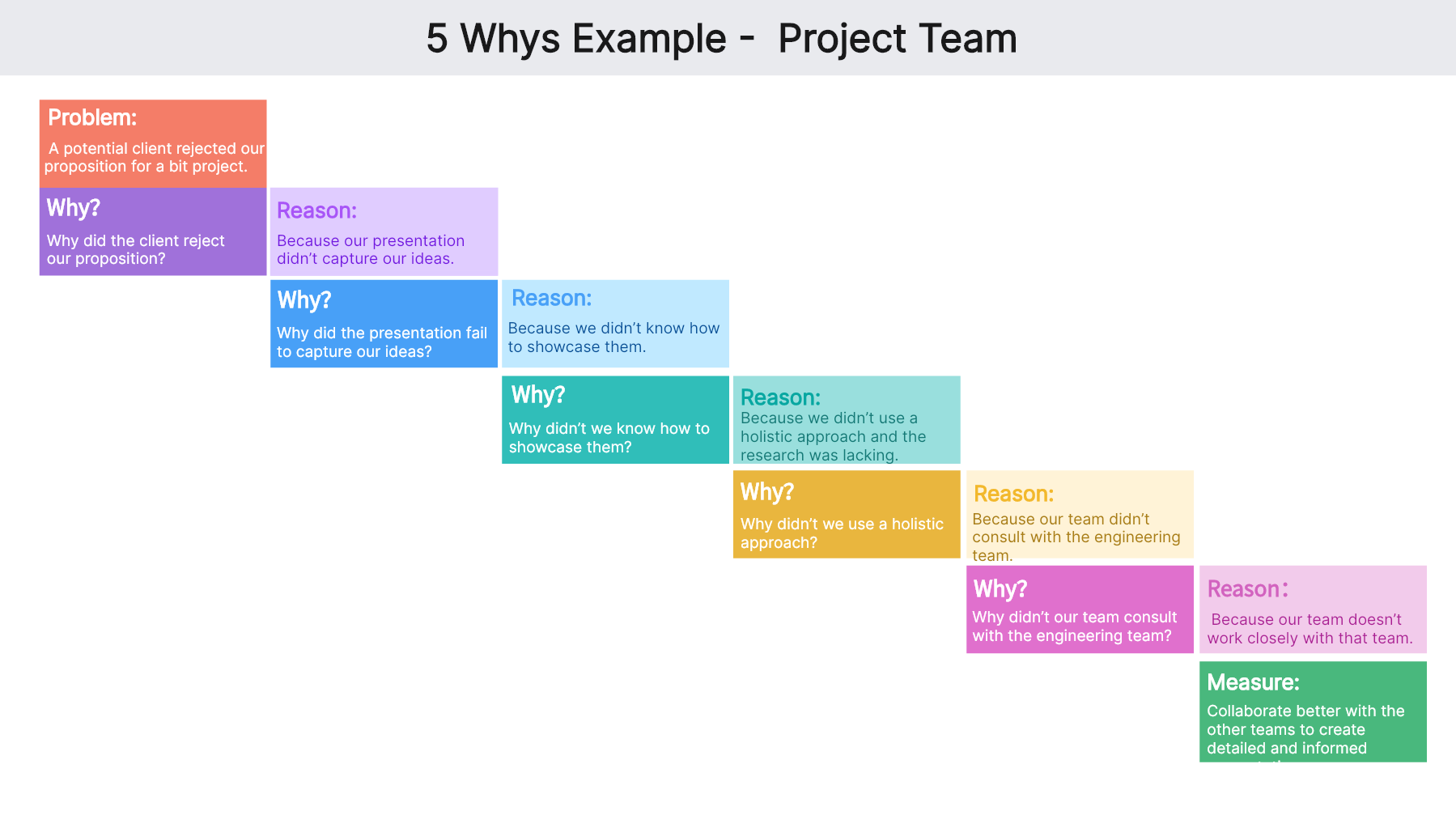
Problem – A potential client rejected our proposition for a bit project.
- Why 1 – Why did the client reject our proposition?
- Reason – Because our presentation didn’t capture our ideas.
- Why 2– Why did the presentation fail to capture our ideas?
- Reason – Because we didn’t know how to showcase them.
- Why 3– Why didn’t we know how to showcase them?
- Reason – Because we didn’t use a holistic approach and the research was lacking.
- Why 4– Why didn’t we use a holistic approach?
- Reason – Because our team didn’t consult with the engineering team.
- Why 5– Why didn’t our team consult with the engineering team?
- Reason – Because our team doesn’t work closely with that team.
Measure/Solution – Collaborate better with the other teams to create detailed and informed presentations.
5 Whys Example - Personal Life
The final 5 whys example will highlight how you can use this analysis for your personal life. This is a very useful tool that you can apply to every aspect of your life to uncover all the causes of your problems.
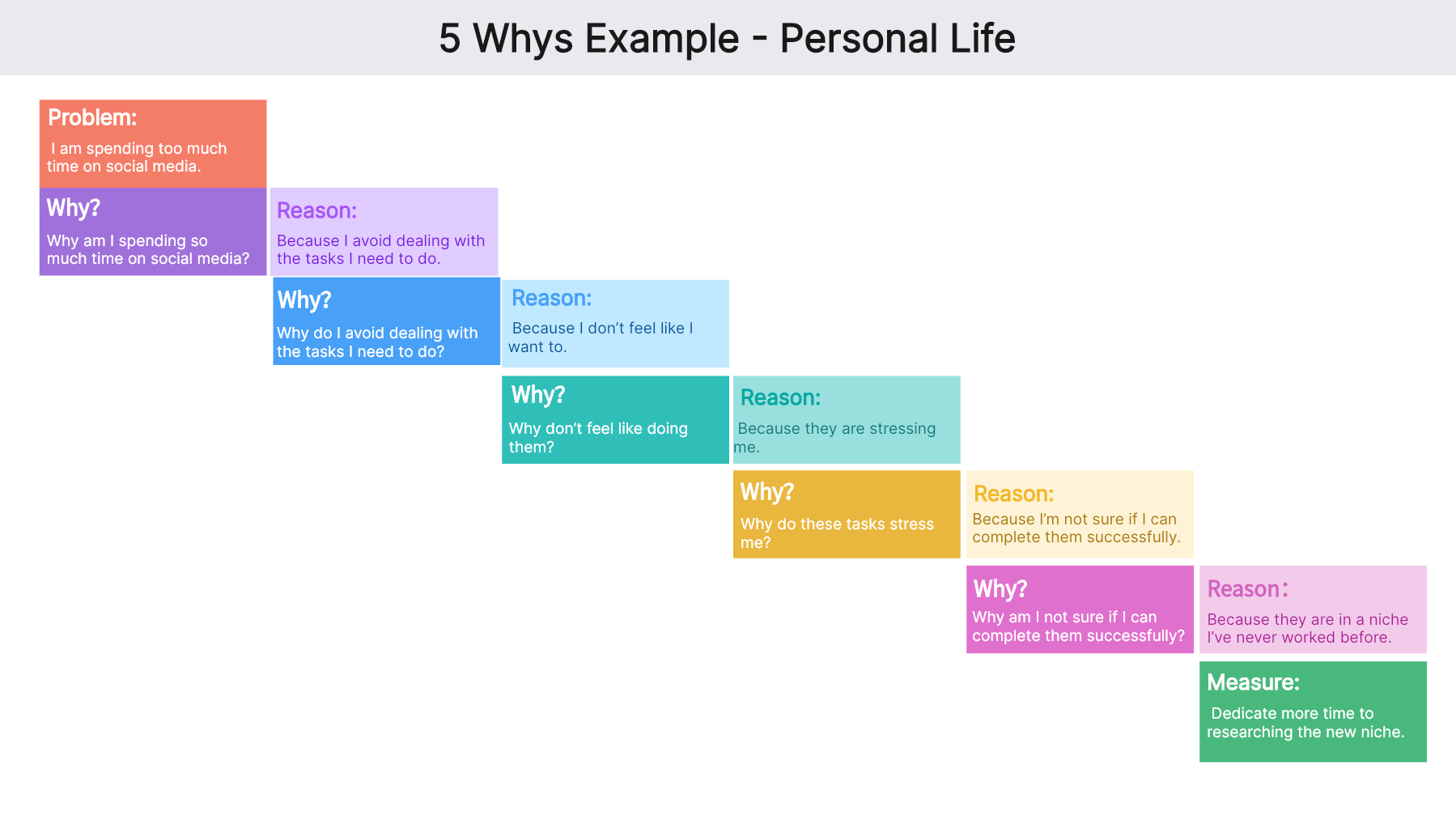
Problem – I am spending too much time on social media.
- Why 1 – Why am I spending so much time on social media?
- Reason – Because I avoid dealing with the tasks I need to do.
- Why 2– Why do I avoid dealing with the tasks I need to do?
- Reason – Because I don’t feel like I want to.
- Why 3– Why don’t feel like doing them?
- Reason – Because they are stressing me.
- Why 4– Why do these tasks stress me?
- Reason – Because I’m not sure if I can complete them successfully.
- Why 5– Why am I not sure if I can complete them successfully?
- Reason – Because they are in a niche I’ve never worked before.
Measure/Solution – Dedicate more time to researching the new niche.
How to Use the 5 Whys Technique
As you can see, you can create a 5 whys example for every situation in your life and your business. Therefore, you might be wondering how you can use this technique. Fortunately, this analysis only takes a few simple steps.
Here is how to create a 5 whys root cause analysis example for your organization:
Step 1 – Define the Problem
The first step to creating 5 whys example is to clearly state the issue. If you want to, you can also gather a team that will be a part of the whole process.
Step 2 – Start Asking Why
Then, you ask an initial why. In this stage of the 5 whys analysis example, you will find the surface-level causes. However, each subsequent why will unveil the deeper causes.
Step 3 – Find the Root Cause of the Issue
After the final why, you will have uncovered all causes and effects. In this final stage of the 5 whys root causes analysis example, you will have an actionable measure that you can apply.
Step 4 – Implement the Solution
Once you have reached a solution, implement it to fix the problem.
Step 5 – Evaluate its Effectiveness
After a while, evaluate the effectiveness of the solution. If the results didn’t satisfy you, analyze the problem once more.
Practice – Find the Root Cause of a Problem Using Boardmix 5 Whys Template
Every 5 whys example is different. Thus, the only way to see if you’ve understood this technique is to apply it to one of your own problems. You can do that quite easily by using Boardmix. This online collaborative whiteboard tool is ideal for creating any type of diagram you might need, both for personal and professional use.
Right now, Boardmix makes it easier than ever to create anything you need since it has a rich library of ready-made templates. Therefore, we are going to use the tool’s template to create the 5 whys analysis example in just a few simple steps.

Here is how to create your own 5 whys root cause analysis example in Boardmix.
Go to your Boardmix workspace and click the New from template button. Then, browse the library and select the 5 whys analysis.
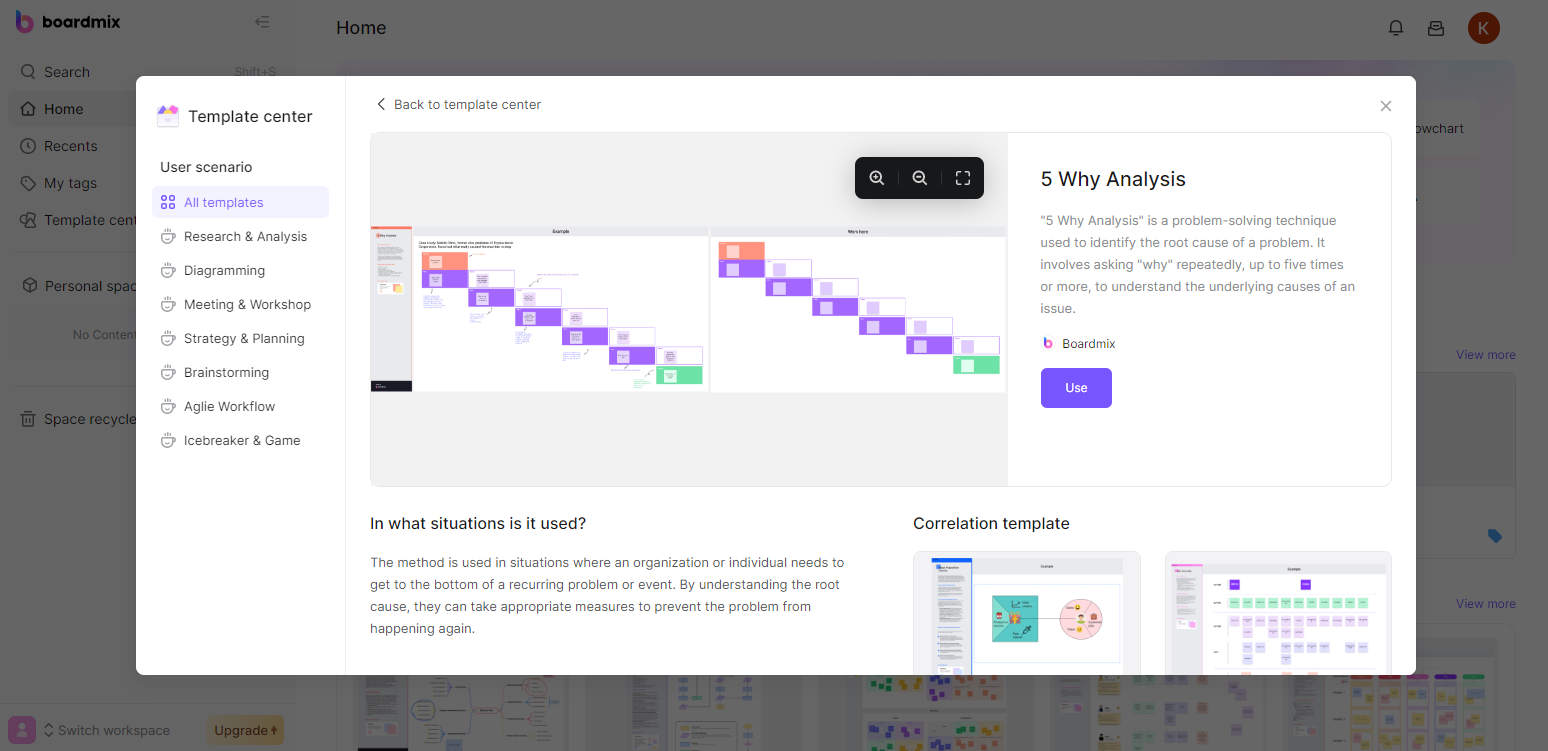
Wait for the template to load, and see each section for the whys and the reasons.
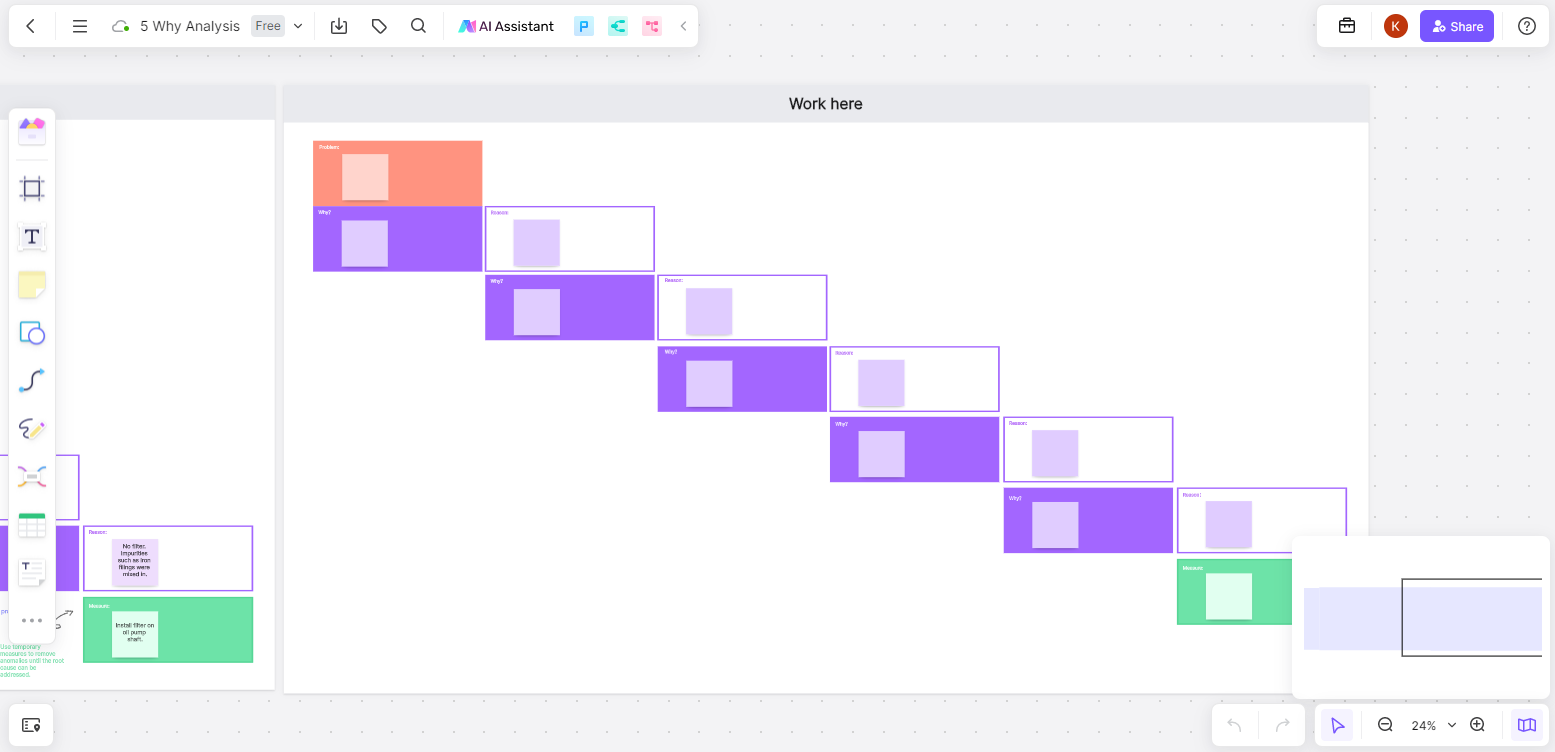
Fill in all the relevant information until you reach a measure.
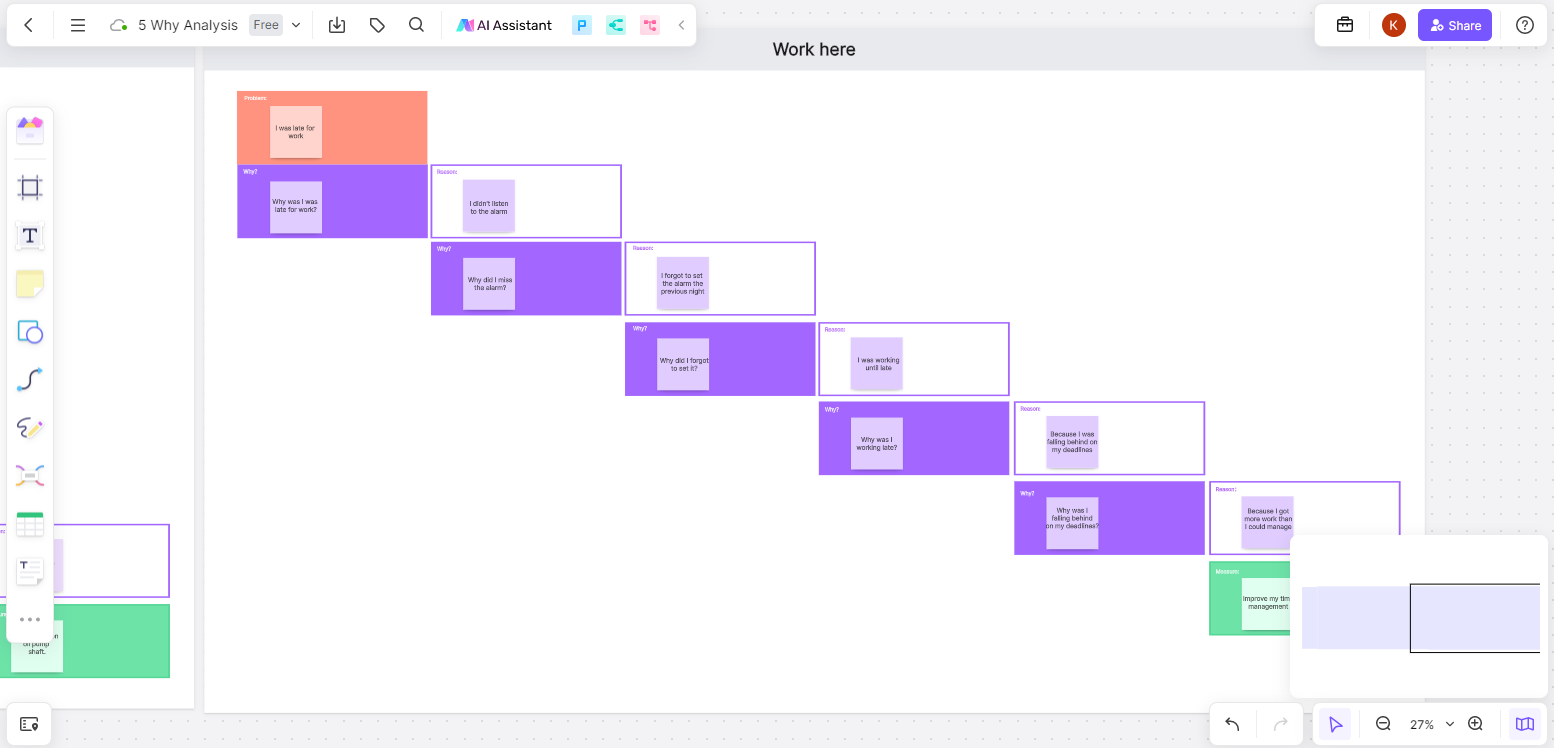
If you want to share or invite a collaborator, you can click the Share button at the top right corner of the screen. Your 5 whys analysis example is ready!
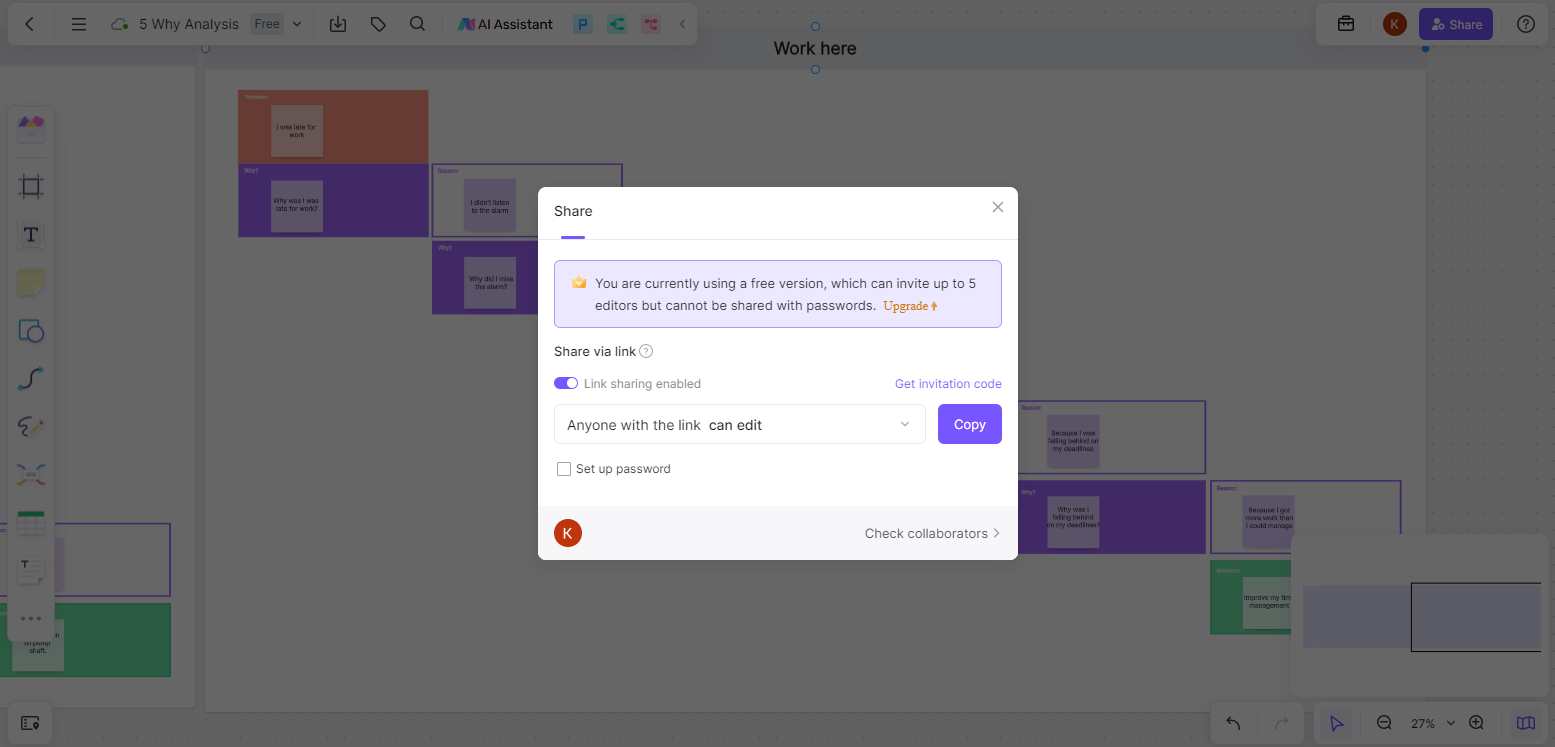
Bonus: 5 Whys Vs. Fishbone Diagram
5 whys is just one problem-solving methodology. Another common is the fishbone diagram. Below, we will examine the similarities and differences of these tools.
Similarities
The most obvious similarity is that both the 5 whys and the fishbone diagram are used to find the root causes of problems. Both of these tools allow you to dig deeper by finding multiple causes that are seemingly unrelated. This way, you get a better understanding of the issue, which also contributes to its effective solution.
Differences
Just a glance at the 5 whys analysis and the fishbone diagram will show you that one of the most obvious differences is their form. In 5 whys, you analyze the problem in 5 levels, while you don’t have any such limitation to the fishbone, where you can add as many branches as you need.
Besides, a difference between these two methodologies is their execution. A fishbone diagram recognizes and categorizes several root causes, while the 5 whys technique analyzes a single one but way deeper. For this reason, these two methods are often combined.
In Conclusion
This comprehensive guide shows you how to use the 5 whys analysis to your advantage. Use Boardmix’s preset 5 whys template to solve the problem you are dealing with. The great thing about this tool is that you can take use of the AI Assistant that can collect and analyze data for you. You can even use it to generate various diagrams, templates and codes based on your needs!









